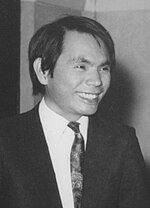Bui Tuong Phong
Bùi Tường Phong | |
|---|---|
 Phong in 1969 | |
| Born | December 14, 1942 Hanoi, French Indochina |
| Died | July 1975 (aged 32) California, U.S. |
| Nationality | Vietnamese |
| Alma mater | University of Utah |
| Known for | |
| Scientific career | |
| Fields | Computer science |
| Doctoral advisor | Ivan Sutherland |
This article needs additional citations for verification. (March 2022) |
Bui Tuong Phong (December 14, 1942 – July 1975) was a Vietnamese-born computer graphics researcher and pioneer. He invented the widely used Phong shading algorithm and Phong reflection model.
Life
Phong was born in
He went to the University of Utah College of Engineering in September 1971 as a research assistant in Computer Science and he received his Ph.D. from the University of Utah in 1973.[1]
Phong knew that he was terminally ill with leukemia while he was a student. In 1975, after his tenure at the University of Utah, Phong joined Stanford University as a professor.[2]
Phong was married to Bùi Thị Ngọc Bích from Nha Trang, Vietnam, in 1969 in Paris, France. He and his wife had one daughter.[citation needed]
According to Professor Ivan Sutherland and Phong's friends, Phong was intelligent, affable and modest.[citation needed] About improving the quality of synthesized images he wrote: "We do not expect to be able to display the object exactly as it would appear in reality, with texture, overcast shadows, etc. We hope only to display an image that approximates the real object closely enough to provide a certain degree of realism."[3]
Two years after receiving his Ph.D., Phong died in 1975 of end-stage leukemia.[4]
Work on computer graphics
Phong was the inventor of the Phong reflection model and the Phong shading interpolation method, techniques widely used in computer graphics. He published the description of the algorithms in his 1973 PhD dissertation[5] and a 1975 paper.[6]
He developed the first algorithm for simulating
Phong, Robert McDermott, Jim Clark and Raphael Rom had created the very first computer graphics–generated picture that looked like its physical model: the Volkswagen Beetle. As a computer graphics icon, it still crops up in highly respected journals and animated features.[7]
See also
- Blinn–Phong shading model
References
- ^ "University of Utah - History of the School of Computing". University of Utah. 2007-06-07. Retrieved 2007-08-26.
- ^ "View Content". ulink.utah.edu. Retrieved 2022-07-16.
- ^ http://www.cs.northwestern.edu/~ago820/cs395/Papers/Phong_1975.pdf [bare URL PDF]
- ^ "University of Utah Alumni". ulink.utah.edu. Retrieved 2021-10-03.
- ^ Bui Tuong Phong, Illumination of Computer-Generated Images, Department of Computer Science, University of Utah, UTEC-CSs-73-129, July 1973.
- Comm. ACM, Vol 18(6):311-317, June 1975.
- ^ McDermott, Robert (2003). "Robert Remembers: The VW Bug" (PDF). University of Utah Dept. of Computer Science. p. 7. Archived from the original (PDF) on December 29, 2009. Retrieved 2009-10-08.
